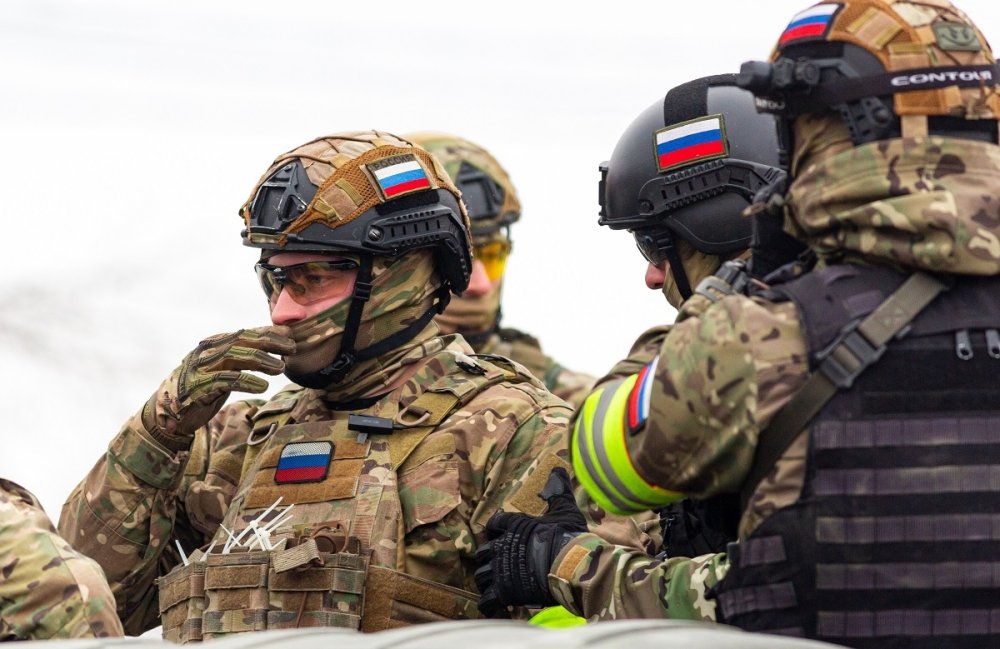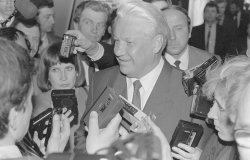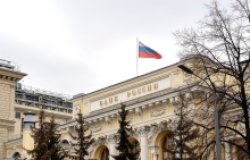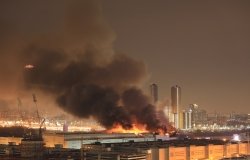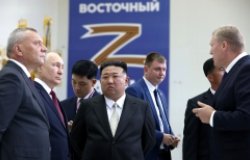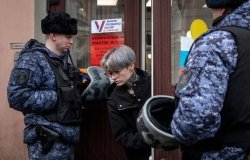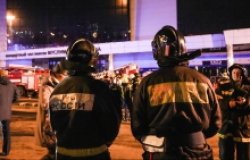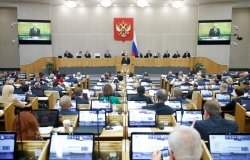
A blog of the Kennan Institute
The West Should Brace for Long-Term Deterrence of Russia
After months of political wrangling the Ukraine military aid package cleared both chambers of Congress and was signed by the president on Wednesday. This is an important milestone signaling bipartisan support for the Ukrainian cause. Yet, although immediate shipments were promised, a substantial portion of the package—$48 billion out of nearly $61 billion—will pay for replenishing U.S. weapons stockpiles and producing new equipment for Ukraine.
Russia, meanwhile, shows no signs of curbing its confrontation with the West. Regardless of how long Ukraine can withstand the onslaught of the Russian war machine, or whether the United States and Europe can continue providing support to Ukraine, the current season of confrontation between Russia and the West promises to be a long one.
Not Provoking the Aggressor?
Russia will remain a threat to the United States and its allies for a long time to come, analysts Miranda Priebe and Samuel Charap write in a RAND research report (for a quick read, see the research brief with a summary). They paint two scenarios. In the one more favorable to the United States, the war ends quickly, the ceasefire is sustainable, and the Russian war machine is severely weakened. In the less favorable (and potentially more likely) scenario the war of attrition lasts a long time, the ceasefire is unsustainable, and Russia is not weakened enough to cease preparations for the next imperialist wars.
In both more and less favorable scenarios, the RAND report says, the United States could adopt softer or tougher policies toward Russia. By choosing relative softness, the United States would signal it was willing to negotiate with Russia. It would not send additional military forces to Eastern Europe, and it would show restraint in providing political and military support to countries threatened by Russia. If it chose relative toughness, the United States would continue efforts to gain Ukraine accession to NATO and would seek to punish, contain, and weaken Russia for its aggression.
This leads to a matrix of four scenarios. If Russia is significantly weakened by the war, the U.S. hard approach leads to Cold War 2.0. The soft approach leads to “cold peace.” If Russia quickly rebuilds its military machine after the war, the U.S. soft approach leads to localized instability and the hard approach to widespread, pervasive instability.
If Russia’s aggressiveness continues unabated and the United States pursues a tough policy, international tensions will rise rapidly, Russian-Chinese cooperation will deepen, NATO-Russia relations will deteriorate further, and global economic fragmentation will increase. With a softer policy, the United States weakens its support for European NATO countries. U.S. relations with Russia improve slightly. China’s ties with Russia do not strengthen, and global trade does not fragment into competing blocs. The United States is less involved in the conflict with Russia and can shift its focus to the rivalry with China. This scenario is very similar to Trump’s possible policy in 2025.
Priebe and Charap conclude that the best scenario for the United States is one in which Russia is weakened as much as possible by the war and the United States pursues a soft policy afterward. The worst scenario is one in which Russia’s war machine remains strong and the United States pursues a tough policy.
This conclusion and reasoning may seem logical: both strategically and economically, peace is better than war, and global war is worse than local war. The problem, however, is that the likelihood and intensity of the war Russia is waging are determined less by the hawkish or dovish policies of the United States than by the capabilities and desires of the Kremlin. Russia is not losing the current war of attrition, and the longer the war goes on, the less likely are the scenarios favorable to the United States. The Russian war machine is clearly accelerating.
For Russia to be significantly weakened at the end of the war with Ukraine, aid to Ukraine now would have to be much more timely and massive. The current difficulties the United States and Europe are experiencing in providing timely, adequate military assistance to Ukraine reduce the likelihood of a cold peace and new Cold War scenarios. Having ended the war with Ukraine, Russia may be almost ready for new wars.
Priebe and Charap seem to underestimate Russia’s willingness and ability to continue waging war in Eastern Europe and overestimate the beneficial effects of U.S. peacemaking. They also assume that a soft U.S. policy will help avoid a Russian conflict with NATO members. However, the likelihood of such a conflict depends much more on events and attitudes in Moscow than on events and attitudes in Washington. If the Kremlin's appetite for risk continues to grow, a soft U.S. policy will only encourage an attack.
The real consequence of the softer U.S. policy could be what we have seen online in recent months: Ukraine's weapons deficit, the accelerated pace of Russia's offensive, and direct signals that the offensive will not be limited to Kharkiv or even the whole of Ukraine. What provokes Russia most is not the West's strength and toughness but its weakness, its fragmented and delayed efforts, its indecision and half-heartedness, and the many holes in European and transatlantic unity.
Stopping Russia
The authors of the CEPA report, edited by Sam Greene and SaraJane Rzegocki, have a much more realistic view of Russian politics. They take seriously the claims of Putin and his associates that from 2022 on, Russia has been at war not with Ukraine but with the West. Even the end of the Russia-Ukraine war will not stop Russia’s war with the West. Russia’s challenge to the West is not limited to Ukraine and will not disappear in the coming years.
This is exactly what Putin and his associates are warning the West about. The chances are very high that Russia will continue its war with the West after Putin leaves office.
Russia’s goals now, according to the CEPA report, are as follows:
- To maintain the power of Putin’s elite through the military mobilization of society;
- To change the world order by depriving the United States of its primacy and changing the international norms and rules that have brought prosperity to much of the world since 1945; and
- To gain military, political, and economic dominance in the post-Soviet space.
To counter these attempts, the United States should not only contain Russia but also deny it the ability to wage war in Europe and in the post-Soviet space, now and in the future.
This will require attention and vigilance. Deterrence is the only alternative to escalation, says the CEPA report, whose authors echo George Kennan's famous cable. A new deterrence strategy should include a strengthened NATO commitment to defend the Eastern bloc countries, countering Russia's attempts to destabilize Western societies and influence their politics, and a principled refusal to accept that the post-Soviet countries are an area of interest to Moscow. Similar recommendations to the U.S. authorities can be found in the CFR report, written by Liand Fix and Maria Snegovaya, and the CNAS report, prepared by Andrea Kendall-Taylor.
The strategy of deterrence involves supplying Ukraine with weapons not "as long as it takes" but "as quickly as possible." This requires a significant strengthening of transatlantic and European solidarity to overcome the strategic weakness of the West. It requires a significant increase in U.S. and European engagement in Moldova, the South Caucasus, and Central Asia, including, curiously, assistance to China in building alternative trade routes between Southeast Asia and Europe.
In the absence of a firm and coherent deterrence strategy, Russia will continue to pose threatening challenges to NATO and Europe. The goal of deterrence should not be the defeat or collapse of Russia. During the Cold War, the goal of the United States and Western Europe was not the defeat or collapse of the USSR. It was to preserve world order, protect the United States and its allies, and prevent further destabilization of the international order. Doing so this time will be difficult and will require determination, consistency, internal unity, and a great deal of patience.
The opinions expressed in this article are those solely of the author and do not reflect the views of the Kennan Institute.
See our newest content first.
Subscribe to receive the latest analysis from the Russia File
About the Author

Boris Grozovski
Journalist and public educator; author of Telegram channel EventsAndTexts

Kennan Institute
The Kennan Institute is the premier US center for advanced research on Eurasia and the oldest and largest regional program at the Woodrow Wilson International Center for Scholars. The Kennan Institute is committed to improving American understanding of Russia, Ukraine, Central Asia, the South Caucasus, and the surrounding region though research and exchange. Read more
